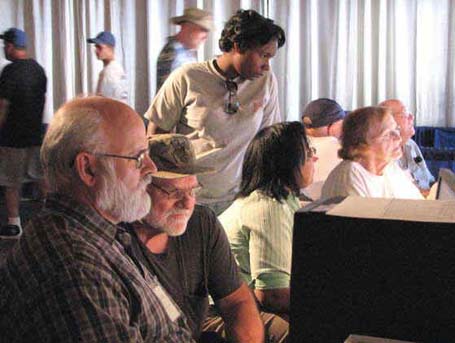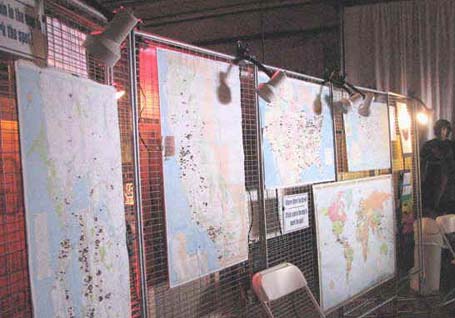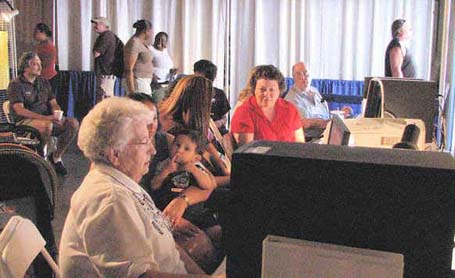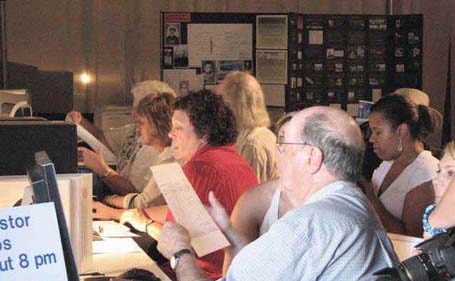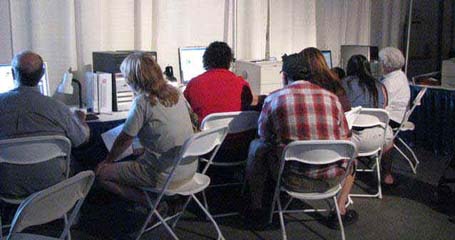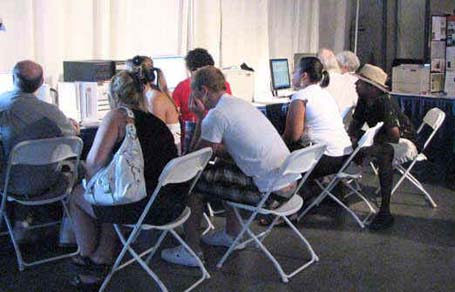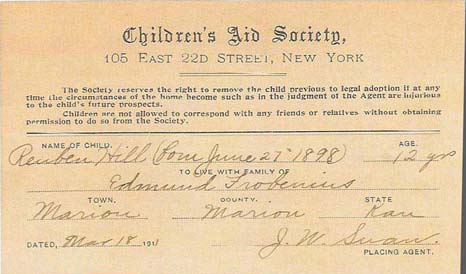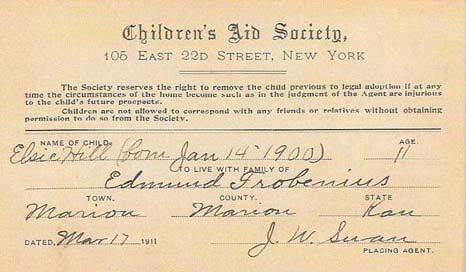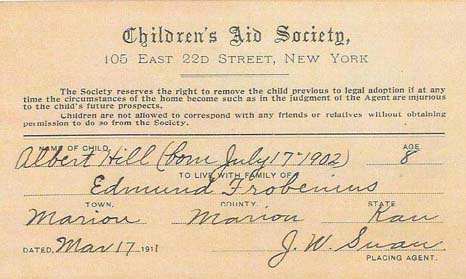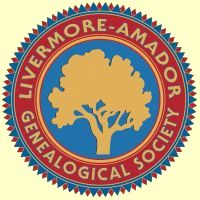 |
The Livermore Roots Tracer
Volume 27 Number 3
August 2007
Editor: Jane Southwick
Reporters: Kay Speaks, Marie Ross, Lois Barber, Lois Smith
Compositor: George Anderson
Web Editor: Vicki Renz
Printing/Distribution: Sandra Caulder
Staff Contributors: G.R.O.W - Frank Geasa
Livermore History - Gary Drummond
Our e-mail address: rootstracer@l-ags.org |
The Roots Tracer is the quarterly publication of the Livermore-Amador Genealogical
Society. The mission statement of the Roots Tracer is: "Instruct. Inspire.
Inform." We encourage members to submit articles for publication. Material can be
e-mailed to: rootstracer@L-AGS.org or mailed to
L-AGS, P.O. Box 901, Livermore, CA 94551-0901.
Queries are free. Please send your queries to querymaster@l-ags.org.
Table of Contents

|
A Message from Our President
Anne Marshall Homan
|
In the previous Roots Tracer, I thanked those of you who worked on the
seminar; this time I must thank the many members who manned our genealogy booth at the
Alameda County Fair. I signed up for two slots this year, and I learned for myself what
everyone had said - it was fun! Gail Bryan deserves special kudos for ramrodding the
affair for us.
When our home was threatened by fire, one of the last things I thought of saving was my
genealogy records. Unfortunately, they are not on a computer because the computer I was
using at the time is so out of date that I cannot retrieve the records. So, they are on
paper in a filing cabinet - not what I would save in a last ditch effort to gather
materials as I was fleeing from flames. Fortunately, I did not have to make those choices
since the volunteer firefighters up here in Morgan Territory did a marvelous job in
keeping the grass fire from involving our buildings. But it did make me think that I had
better get those records on my laptop soon!
The programs planned by Arleen Wood continue to entertain us and give us new
information. Beth Twogood's presentation in June was very well done and gave us some
creative ideas about family get-togethers. In July, Jane Lindsay and Colleen Huntley
invited us to the new Oakland headquarters of the California Genealogical Society and
teased us with lists of information available in their library - for example, the Argonaut
Index, the records of the Halsten-Gray Mortuary 1859-1957, the burial records of IOOF and
a vertical file. If you are not a member, there is a $5 reader's fee; the first Saturday
of each month is free. A BART station is not far away.
I turned in our petition for Ancestry.com to Rosemary Dukelow at the Livermore Library.
Many of you signed it at the July meeting. Hopefully, that and the news that the FHC in
Livermore no longer carries Ancestry.com will persuade the powers-that-be in the library
administration to grant our request.
We have tentatively scheduled our December meeting to start at 7:00. This year is our
30th anniversary, so we wanted a little more time than usual to visit and eat cake after
the regular program. Invite friends who used to be members of L-AGS to attend and
celebrate with us. Of course, your friends who might become new members are also welcome
to join us.
Return to Table of Contents
Welcome to Our New Members
W.
Edward King, Marie (Ferrario) Timmer, Kelly Glenn,
Pat Williams, Pennie Clouser, Ellen Fletcher |
We are grateful for the generosity of these members of L-AGS:
Patrons
Kay Speaks, David Steffes, Duncan Tanner
Benefactors
James Bahls, Sandra Caulder, Sandy & DeLynn Clark, Ted & Gail Fairfield,
Richard & Wanda Finn, Richard & Jean Lerche, David & Bernice Oakley, Betty
Ryon
Total Membership as of July 23, 2007: 234
Individuals
Return to Table of Contents
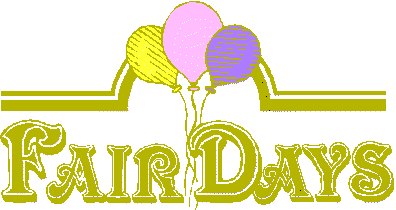 |
Memories of the Alameda County Fair 2007
By Gail Bryan |
We completed our seventh year at the fair in 2007. Our booth seems to get more popular
every year. A big "Thank You" to all the volunteers who helped to make it a
success. Many worked double shifts to fill in empty gaps.
We did cut back our hours and had three computers instead of four as in years past. We
did this because the fair administrators wanted to give out fewer volunteer tickets. We
also staffed the booth for fewer hours on the slow days of Monday, Tuesday and Thursday,
because fair attendance is usually smaller on those days. Our hours on the
"slow" days were 1 p.m. to 7 p.m., while on other days they were 11 a.m. to 8
p.m. All days were divided into three-hour shifts. A greeter was available on all shifts.
The greeter has an important job that introduces visitors to our booth and explains that
our purpose at the fair is to help people who want to start their family history and who
want ideas on where to start. Many visitors ask, "How much does it cost?" And of
course, it is free.
We also had our maps on which visitors could put pins to show where they were born. A
map of Europe was added this year because many of our visitors are from Europe. Our United
States map had a pin in every state except Delaware.
We also want to thank Renee Ramig who was building coordinator again this year. She
gave us the same spot as last year; right up by the front door and visible when people
entered the building. She and her staff were always ready to help with problems, and
supplied us with printer paper and additional copies of our handouts of "Free
Internet Websites" and Pedigree Charts.
Our Livermore-Amador Genealogical Society (L AGS) was joined by other organizations:
- The Josefa Higuera Livermore Chapter of the National Society of the Daughters of the
American Revolution (DAR)
- Tracy Area Genealogical Society (TAGS)
- San Ramon Valley Genealogical Society (SRVGS)
- The California Genealogical Society (CGS)
- The Amador Livermore Valley Historical Society (ALVHS)
- Family History Centers (Livermore & Pleasanton)
We each had our own special experiences in helping people, and in receiving
appreciation from those we helped. But I feel the best comment I had was one from Renee.
She had acquired the latest technology for her building, with four Wii Game Stations and
other high-tech devices. She asked a friend who visited, "What was your favorite
thing in my building?" and was told "putting a pin in the map where I was
born."
Let's hope we can do it again next year. Again "Thanks" to all.
Return to Table of Contents
We Get As Well As Give
By Jane Southwick |
The volunteers at the fair booth are there to "give information." However, I
found that we are also there to "receive information." John, a very nice
gentleman from Fremont, stopped by to see how we were doing and said he knew about our
L-AGS organization. He wanted us to know about a Web site he has created. On this site he
is indexing all of the ships and ship passengers that came to California during the gold
rush. The site also contains wagon train lists and Isthmus of Panama information, and is
fully searchable. You will find it at www.pt5dome.com.
One of the reasons we have established our genealogy booth at the County Fair is to
encourage visitors to start thinking about their family history. One way we can do this is
to show them what is available on the Internet while they are sitting with us at the fair,
and then provide them with a list of Web sites they can take home to use in looking for
their families. We are grateful to Frank Geasa for composing this Web site list. He also
composed a list of foreign Web sites that were in the book that Kay Speaks put together.
This book contained finding aids and databases to be used as a reference.
These valuable lists are too long to reprint in the Roots Tracer, but they will be
posted on our Web site soon. That alternative has the added advantage of allowing all of
the numerous links to be clickable.
Return to Table of Contents
Fun at the Fair
Photos by Gail Bryan |
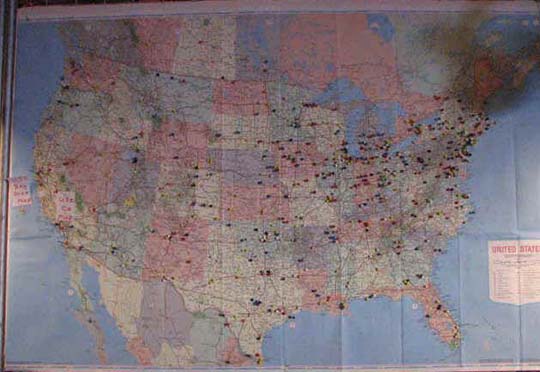 |
Our United States map with the pins of the birthplaces
of visitors to our booth at the Fair. |
Many volunteers filled many shifts at the fair, including, in some cases, more than one
a day. Thanks to you all!
Return to Table of Contents

|
G.R.O.W.
Genealogy Resources On the Web - The Page That Helps Genealogy Grow!
Compiled by Frank Geasa |
- This Ridgewood Public Library site has indexes of the Bergen County, New Jersey state
censuses for the years 1885, 1895, 1905 and 1915. Bergen County is across the Hudson River
from New York City.
- http://www.ridgewoodlibrary.org/localhistory/local_history_census_index.htm
-
- If any of your ancestors served in the Australian Army during World War I, you may find
the contents of their service records in digitized format at:
- http://www.naa.gov.au:80/the_collection/gift-to-the-nation.html
-
- The Marin County Genealogical Society (California) has an ongoing project underway to
index that county's marriage and birth records from 1900.
- http://www.maringensoc.org/Resources/marriages-births.htm
-
- Online indexes, organized by county, of naturalization records for the state of Michigan
are available at this History, Arts and Libraries site.
- http://www.michigan.gov/hal/0,1607,7-160-17449_18635_20684---,00.html
-
- If your ancestry includes Belgian lines, you might want to visit this site of the
Belgian Researchers, which includes some databases both in the USA and in Belgium.
- http://www.rootsweb.com/~inbr/index.html
-
- The Soldiers of Gloucestershire Museum (UK) has a search list with some data on over
40,000 soldiers of The Gloucestershire Regiment in World War I.
- http://www.glosters.org.uk/
-
- This growing site has free BDM indexes of over 134 million England & Wales records
since 1837.
- http://freebmd.rootsweb.com/
-
- The Contra Costa County Genealogical Society (California) has online birth, marriage and
death indexes as well as several voter registers from the late 1800s. There is also a list
of burials at Oakview Cemetery, Antioch.
- http://www.cccgs.org/
-
- The Kansas State Historical Society has an ongoing project of indexing the 1895 state
census. Many counties have been completed and can be searched. The site also lists films
for censuses and other subjects which can be borrowed through interlibrary loan.
- http://www.kshs.org/genealogists/census/
-
- If your ancestry search includes Newfoundland you will want to visit this Newfoundland
Grand Banks genealogy site which has a treasure trove of genealogy search lists including
vital records, immigration, voters' lists and much more.
- http://ngb.chebucto.org/index.html
-
- The Bay County Genealogy Society of Florida (Panama City) has several search indexes
including marriage, obituary and cemetery on their site with more transcription projects
in progress or planned.
- http://www.rootsweb.com/~flbcgs/index.html
-
- This Oklahoma District Court site has public record indexes, including marriages. Some
records such as Willie Alexander's are from decades before the inclusive dates shown.
- http://www.odcr.com/
-
- This San Fernando Valley Genealogical Society (California) has online alphabetical lists
of names in local newspaper obituaries 1911-1945.
- http://www.rootsweb.com/~casfvgs/data3.html
-
- If your genealogical interest includes Lincoln County, Nebraska, this site offers
interesting reading (Buffalo Bill and WWII troop train canteen) as well as search lists
for cemeteries, WWI draft registrations and others. One rather unusual list is a Union
Pacific Railroad seniority list.
- http://www.lincoln.wathenadesigns.com/index.html
-
- If you are researching in South Carolina, that state's Department of Archives &
History has several searchable indexes including Confederate pensions, state land grants
and wills at this site.
- http://www.archivesindex.sc.gov/Archives/default.asp

Return to Table of Contents
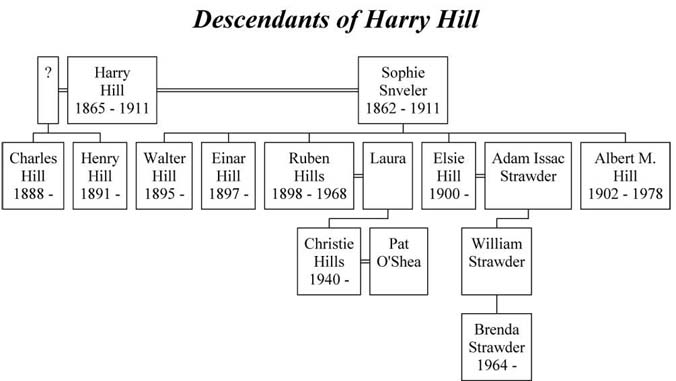 |
The Orphan Train - Christie O'Shea's Story
As told to Jane Southwick |
When Christie Hills was growing up in Turlock, California, her family spent their
summer vacations driving to Kansas to visit her father's relatives. Her father was Ruben
Hills. (When Ruben was much younger the last name was Hill, and sometimes his first name
was spelled Reuben.) The family visited Christie's Aunt Elsie, in Neosho Falls, Kansas,
and her Uncle Mike (first name, Albert) in Leroy, Kansas, and her grandparents, Edmund and
Minnie Frobenius, on the farm in Spring Creek, Kansas. It wasn't until much later, that
Christie found out that Edmund and Minnie were not her real grandparents.
Christie moved to Livermore, California to work, and met and married her husband Pat
O'Shea. In 1962, Christie and Pat drove to the airport to greet her Uncle Walter, and
drove him to Turlock for a reunion with Christie's father, Ruben. Walter Hill had been
looking for his brother, Ruben/Reuben Hill for a very long time. This is when Christie
discovered that her father had ridden on the Orphan Train when he was 12 years old. At
that time, she was so busy with her work and her family, that she did not have the time to
think about the importance of the Orphan Train.
In 1995, she watched a PBS presentation about the Orphan Train and realized this was a
very important happening. She set about trying to find out as much as she could about her
father's experience. She had an old newspaper article that had been published in the
Turlock Journal, Thursday, September 13, 1962, which described the reunion between her
Father Ruben and her Uncle Walter. It told about their younger lives, but it didn't
mention the Train.
One day when Christie and I were playing golf, she asked me what I knew about the
Orphan Train. Although I didn't know much then, I found an article for her in the
July/August 2003 Family History Magazine about "The Orphan Train Movement." In
this article, there were sources and databases she could use to contact organizations
about her family. One of the very best ones was www.orphantrainriders.com.
There was also a Kansas web site, www.kancoll.org,
and the Children's Aid Society at www.childrensaidsociety.org.
Christie contacted the editor of the orphan train riders web site, a Mr. D. Bruce
Ayler. When Mr. Ayler answered her e-mail with facts about her family, he included the
name of someone who was also looking for this family. The person turned out to be Brenda,
a first cousin once removed, who lived in Kansas. They began sending information to each
other. Brenda had written to the Children's Aid Society asking about her grandmother,
Elsie. With the answer she received, there were copies of letters that had been sent to
Albert in 1944, and to Elsie in 1961. These letters described the members of the family,
including the parents, and the reasons why the children had been placed in an orphanage.
One of Brenda's greatest finds was an item on E-Bay. Someone was selling three antique
1911 Children's Aid Society of New York Adoption cards. These placement cards happened to
be for Reuben, Elsie and Albert Hill. The odds against such a coincidence must be
staggering! Brenda was able to obtain the cards and a few pictures. What a thrill! These
items were from the estate of Minnie, the daughter of Edmund and Minnie Frobenius, the
family who had fostered and raised these children.
With all the information that has been obtained, including information from the Federal
Census, Christie and Brenda are now able to tell the story about their family.
The father of this family was Harry Hill. He was born in Finland and came to the United
States in 1882, when he was 17 years of age. He married a first wife, and had two boys,
Charles and Henry born in 1888 and 1891. He was married a second time to Sophie Snveler,
who was also born in Finland. They were married about 1895, and had five children from
1895 to 1902.
In March of 1908, when their father, Harry, an unemployed carpenter, was unable to care
for the children, and their mother, Sophie was very ill, the five children-Walter, Einar,
Ruben, Albert Mickel, and Elsie-were placed in the Orphan Asylum Society of the City of
Brooklyn. After two years, Walter ran away from the orphanage to take a job. This was the
last time Walter had seen Ruben.
The four children stayed in the orphanage until 1911. By that time both parents had
died, and three of the children, Ruben, Albert, and Elsie were surrendered to the
Children's Aid Society on March 4th, 1911. Einar went to live with a farmer in Ferndale,
New York.
The other three children were placed on an Orphan Train going to Kansas. Thirteen days
later, on March 17, 1911, in Marion County, Kansas, Elsie and Albert were chosen by Edmund
and Minnie Frobenius to live and work on their farm. The two children wanted their brother
Ruben to be with them, so on March 18, Ruben joined his brother and sister. They were paid
fifty cents a week. Elsie lived there until she was married. Albert and Ruben left when
they were about 21.
The Orphan Train was begun in 1854. A Charles Brace had formed the Children's Aid
Society in 1853 to care for the thousands of neglected children on the streets and in the
orphanages of New York. Mr. Brace felt that the children could be placed in farms and
homes in the Midwest. There, they could be cared for and grow up to be responsible adults.
This was the beginning of foster care. Over 150,000 children were transported by Orphan
Trains between the years of 1854 and 1930.
Ruben, Elsie, and Albert never talked about their trip on the Orphan Train.
Return to Table of Contents
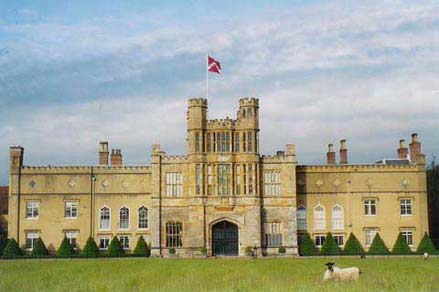
|
Throckmorton Family Reunion in Coughton Court, England
By Beth Twogood |
Coughton Court in Warwickshire, England |
|
Coughton Court has been the home of the Throckmorton family since the early 15th
century. In June 2006, Clare Throckmorton, current resident of Coughton Court, was hostess
to 28 American relatives, including my mother, Peggy Norman, and me. She treated us to a
formal dinner in her beautiful manor house, which is surrounded by prizewinning flower
gardens, and is decorated with historic treasures from the court of Henry VIII.We were
exposed to history that was new and fascinating because the Throckmortons were influential
and involved in risky politics. The family remained Roman Catholic, and was critical of
Henry VIII and his reformation of the Church of England.
After dinner we were entertained in the garden with a production of Shakespeare's Twelfth
Night. Nearby neighbors were happy to join us for this special treat. There is a
small village in the area named Throckmorton, and a connecting road is called Throckmorton
Road. Of course, the village pub is the Throckmorton Tavern. The original village church
was rebuilt in the 15th century by Sir Robert Throckmorton. It contains tombs of early
members of the family. We all enjoyed looking for the name of Throckmorton on the ancient
headstones in the churchyard.
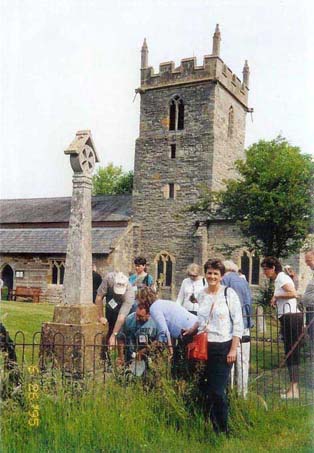 |
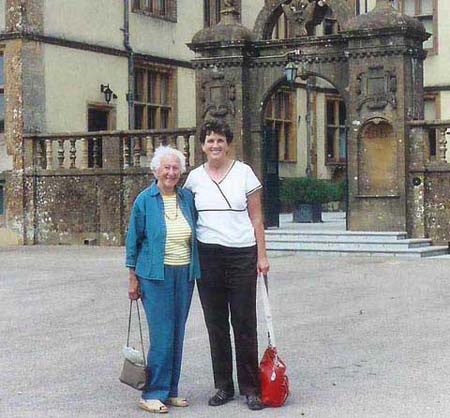 |
| Other Throckmortons and I looking for inscriptions at
the Throckmorton Cemetery. |
Mother and I at Sherborne Castle, the estate of Sir
Walter raleigh and his wife, Bess Throckmorton. |
Elizabeth "Bess" Throckmorton, born about 1575, was named for Queen Elizabeth
I, who was her godmother. When Bess was still very young, she was made the Queen's
maid-of-honor, and at court she fell in love with Sir Walter Raleigh, the Queen's favorite
escort. In 1591 they were married secretly when Bess became pregnant, but secrets were
quickly exposed in the Queen's court. Walter Raleigh fell from the Queen's good graces and
was imprisoned in the Tower of London. Bess was granted permission to live with her
husband in the Tower, where she gave birth to two sons. Eventually, in 1618 he was
beheaded, charged with treason.
Since we were familiar with this love story, we were pleased to have the opportunity to
visit Sherborne Castle, the lovely estate Bess remodeled and decorated when she was
planning a long life with Raleigh. After his death, Sherborne was confiscated, and Bess
was left penniless and heartbroken.
The family proudly proclaims that all Throckmortons are related, and this fact is
confirmed by several scholarly research books published in the past century. Throckmorton
Family History, written by Francis Sitherwood in 1929, includes my father's parents
and siblings, neatly connected to John Throckmorton. He was born about 1600 in England and
arrived in Salem, MA aboard the ship, Lyon, in 1630. During the long and stormy voyage,
John became friends with Roger Williams. When the two men could no longer live under the
strict Puritan laws in Salem, they bought land from the Indians and founded Providence,
Rhode Island.
Several generations later, in 1800, my branch of Throckmortons migrated from their home
in New Jersey to Highland County, Ohio, in a monstrous cloth covered wagon, the Conestoga.
It was a difficult and dangerous trip, but they survived and thrived. Both of my parents
were born in Ohio.
The Throckmorton history has been well documented because this family could read,
write, and keep records as far back as 1100 AD. When we visited the University of
Cambridge, we learned that, starting in 1560, fourteen Throckmortons matriculated, mostly
with law degrees.
This family reunion was voted a big success because we had a great time and learned a
lot of history, both family history and English history.
Return to Table of Contents
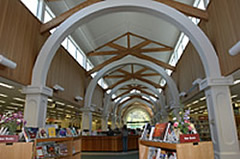
|
Getting Help at the Pleasanton Library, Or - What
Docents Do
By Jane Southwick |
Over the past years I have read the e-mails the docents send to each other about the
patrons they help at the library. I am impressed with some of the people who come in and
ask for help, and the help that is given to them.
The policy is to give information about a patron to the other docents so if the patron
returns on a different day the docent on duty will be aware of what has already been
accomplished. This is a good way to help the docents be more efficient, and ultimately is
of greater benefit to the patron. Sometimes a docent will present a question or a problem
from a patron to the other docents and another docent e-mails back an answer. Some answers
tell where to go on the Web, or what resource to use.
For example: In January, Frank Geasa wrote: I had just one customer
today. She had done some work on her Spann line and had traced it back to a Jordon Spann
who she found on the census and a few other records in Indiana & Illinois. She knows
from those that he was born in Kentucky in 1818, but hasn't been able to find him there or
to find either of his parent's names. We looked rather quickly for the name without luck,
but then I spent about an hour showing her how to use the Heritage Quest digital books to
search for him, as well as introducing her to USGenWeb, RootsWeb, Cyndi's List, NARA, and
how to find the state archives, state libraries and state genealogy societies. She hadn't
made use of these, but up to this point she had used just books and writing letters for
the most part. She was happy to learn of all the other avenues available to explore. She
does have an Internet connection at home but wasn't aware of what was available. We also
spent just a few minutes discussing how she may approach finding another ancestor, James
Grant, in Oregon.
In February, Connie Pitt wrote: One patron was looking for information
on a Stephen Rierson/ Ryerson in North Carolina, Stokes Co. We found a lot of individuals
who had put up information on RootsWeb, and one of those individuals added the father for
Stephen, who was Adian Rierson. This was another person for whom she had been looking.
Patricia has the Internet, but has not really used it for family history. I showed her how
to get onto other Web sites to look up information.
In March, Frank Geasa wrote: I had just one patron, a lady from
Pleasanton who was looking for her Minihan ancestors who migrated from Ireland to Wales to
the USA during the period 1839 - 1862. We didn't find any records immediately, but did
find several promising sites that she is going to pursue from her home computer. After she
left, I found that the Library edition of Ancestry had added the 1851 Wales census
recently and I did find her family on that census and in the parish and county she thought
they might be in. She knew that one ancestor had immigrated to the USA in 1862 but I
couldn't find the family on the Wales 1861 census. I think I did find them on the 1861
English census in Staffordshire. I emailed her the three images involved.
In April, Frank Geasa wrote: It was a fairly quiet day. I had one
young man, Frank, come in looking for his grandfather, Joe Inaudi, who we found in the
1920 and 1930 censuses of San Francisco. He also was looking for a second grandfather, a
Jack or John Varni, also from San Francisco. The best we could do there was to find his
Varni great-grandparents as it appears the grandfather wasn't born yet. Frank has a
computer at home but it isn't hooked to the Internet. He was very surprised at what we
were able to find, and I showed him how to get to several sites, including the San
Francisco Genealogy site. I think he will be returning. Just as I was about to leave,
another gentleman came in looking for an Almasan ancestor in Yuma, Arizona. He had found a
reference to her being on the 1880 census on one of the CDs but didn't know we had the
census available on Ancestry. Pulled it up and printed it. He also wanted to find
information on his Bredlau family from Germany but we didn't manage to do that as it was
getting on to 2 p.m. and I needed to leave. He indicated that many of his aunts and uncles
from that family are still alive and in their 90s. I suggested he talk to them while he
had the chance. He indicated he was going to come back in this evening with a little more
information. He also was very surprised at the amount of information available on the
Internet.
In April, Dick Finn wrote: Only one couple stopped by but they were a
kick. They were interested in finding more about her Hoppe ancestors. They were Germans
from Russia, who had gone to Canada, then to Illinois, and then on to California. We
didn't get too far until the wife said what they really wanted to learn about was her
husband's ancestors, especially Major (his real first name) Rider who lived in
Pennsylvania in 1930. We couldn't find a Major Rider in Pennsylvania in 1930. I suggested
that Major might have been a nickname; no way they said. After a while we did a search of
the entire US 1930 census and there Major was, living in New Jersey. That discovery helped
them find more Rider family members also living in New Jersey in 1930. When I left at 1:00
they had renewed their computer time and were off and running to find more Riders. I don't
know about Mr. but Mrs. was really fired up!
Lois Barber answered Dick Finn: Dick, you will be interested to know
that your Mrs. is hot on the trail of those German-speaking Russians. She is indeed a
kick. I arrived at the FHC tonight at 5:50 and she was waiting by the door. I expect we
will be seeing more of her.
Leo Vongottfried answered both Dick Finn and Lois Barber: Two
comments, one on each side of the couple. The use of titles as first names is an accepted
practice, centered around Georgia in my experience. Whether it is New World Scots or old
South is not clear. Russian-speaking Germans were found along the Volga, imported in large
numbers by Catherine the Great. Stalin gave these Volga Germans a hard time during and
after the Great Fatherland War. Sounds like we're all going to have fun.
Return to Table of Contents

|
Dog Days of Summer - 1941
By Anne Homan |
Genealogy is more than names and dates. It is also discovering what was happening in
the communities in which your ancestors lived. Genealogists have many sources for their
research, and newspapers are an extremely good source. The information in this article was
found in our Livermore Library, which has many old local newspapers on film, with film
readers available. Check out the libraries where your ancestors lived and see what you can
find.
The term "dog days" was coined by ancient Romans. The dog they referred to
was the constellation Canis Major, or Big Dog. Sirius, the brightest star in our sky, is
in this group of stars. As this constellation began to rise just as the sun set, the
Romans believed that the light from Sirius increased the heat from the sun, resulting in
hotter and more humid weather. Officially, this time frame in the Northern Hemisphere is
between July 3 and mid- August. Most of us today, however, consider all of August and even
some of September as dog days - the part of summer that usually is hottest and seems to
last longer as we yearn for cooler days of autumn.
August of 1941 in Livermore was a time when the community worried about our possible
involvement in the war in Europe. Not everyone was lazy in that summer heat before air
conditioning. Red Cross knitters continued their efforts, and Lillian Anderson finished
her flight tests. Town fires reminded the city of the greater danger from possible range
grass fires in this flammable season. And the crickets were at work. Our local newspaper,
the Herald, reported such activities in August of 1941.
Livermore Knitters Add 75 more Sweaters (August 22, 1941 Page 5)
Substantial addition to Livermore's contribution to the Red Cross knitting program was
made Wednesday, when Mrs. M. J. Clark, local chairman delivered 75 sweaters and 2 beanies
to Oakland headquarters. The sweaters were in the following sizes: For 4-year olds, 41; 8-
year olds, 16; men, 5 small, 11 medium; women, 2 medium.
Arroyo Dietitian Wins Pilot's License (August 29, 1941 Page 1)
Miss Lillian Anderson, dietitian at Arroyo Sanatorium, has completed both written and
flight tests which qualify her for a private license. Miss Anderson is not a newcomer to
East Bay aviation activities, having put in several hundred hours on cross country flight
over California and Nevada in recent years on a solo license. Now that this license is no
longer re-issued she has gone into the higher rating. Miss Anderson, who is a native of
Minnesota, has been dietitian at Arroyo for the past eight years.
Takes Blazing Truck to Fire House (August 22, 1941 Page 3)
Roast beef was on the menu for Herb Madsen, meat truck driver, but he didn't know it until
he stopped on First Street a 5 a.m. Tuesday for a cup of coffee. Then, he discovered the
wooden floor of his truck was burning, ignited by flames from a burned out exhaust pipe.
He drove the vehicle to the city fire house and turned in an alarm. The blaze was
extinguished quickly before any appreciable damage was done, and roast meat came off the
menu. Madsen, who resides at 245 East Avenue, San Bruno, is employed by Bayshore Trucking.
Another early morning fire called out the city department at 3 a.m. Thursday when a shed
on the Kelly place on Junction Avenue was destroyed. Loss included a bicycle, some chicken
feed, and a few articles of furniture. The building was beyond saving when the fire was
discovered and Fire Chief H. M. Johnson reported origin of the blaze could not be
determined.
Livermore Has Cricket Invasion (August 22, 1941 Page 1)
Livermore experienced something of a minor scourge of crickets throughout the week as the
insects invaded both business and residential districts. They were nuisances in a number
of stores. Livermore fared well in comparison with nearby communities in the San Joaquin
valley where the invasion was heavy. The bay cities have also been invaded.
Return to Table of Contents
What Was Life Like?
By Dorothy Nell Harrell |
I found a very interesting article on the Web that I thought other members would enjoy:
What life was like in 1906. I realized it was too long for the Roots Tracer, so
Jane Southwick suggested I simply quote the URL:
http://forums.dealofday.com/What_Life_Was_Like_In_1906-t-174829.html
Then Kay Speaks pointed out that by putting the phrase "what was life like
in" (including quotes) into Google gave 28,000 hits describing life from dinosaur
times to the present and for every corner of the globe. Fascinating reading!
Return to Table of Contents
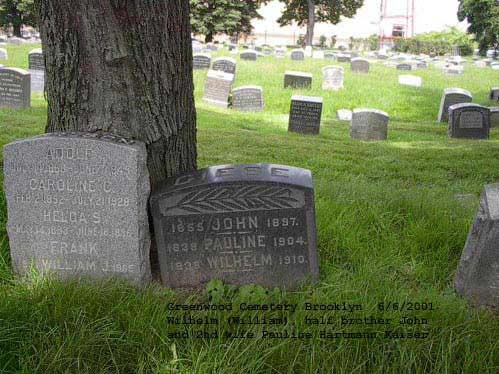
|
Was It the Money?
The Tangled Family Ties of My Great Grandfather Giese
By Frank Geasa |
Greenwood Cemetery, Brooklyn, New York.
Wilhelm (William) Giese, his second wife, Pauline Hartmann Kaiser and his half-brother,
John. |
|
Editor's note: One of the purposes of our Roots Tracer is to instruct and inform.
This article is a very good example of this. As you read you may notice that Frank
mentions at least eight research methods that he used to find the information for this
intriguing story.
When I was growing up I knew very little about my father's family, even his immediate
family. I knew his mother's name was Mary and his father's was William. As to our last
name of Geasa, he knew it had been changed from something else but he wasn't certain from
what - Giese, Geise or something like that was the most I could get from him. When it came
to questions about his grandparents, it was as if they were complete strangers. I thought
perhaps because his own mother had died just after he turned 9, and his father's mother
had died just after he turned 12, there wasn't much discussion of family in the home.
Years later however, after he had died and I started to question older members of the
family, I began to suspect that while that may have been part of the reason, there were
other things also at work here. When I questioned my father's older brother about his
grandfather, I received a curt response that indicated he did not think much of the
grandfather as he had married "all those women." When I later started
researching my great grandfather, I fully expected to find 5 or 6 wives. When I queried a
cousin 18 years my senior, the daughter of my father's oldest brother, she didn't know
much more than I knew, but did allow that her father had talked about the scandal of his
grandfather having married his step-daughter. She also knew the grandfather had lived in
Brooklyn, had his own tugboat and was quite well off. The hint of scandal was intriguing
enough to pique my interest in this man that was my great grandfather.
My great grandfather, Wilhelm August Ludwig Giese, was born in the city of Wismar, in
the Duchy of Mecklenburg-Schwerin (now Germany) on July 5, 1837. His parents were Ernst
Martin Diederich Giese and Ernst's second wife Charlotte Dorothea Maria Boldt. According
to the 1900 census and several other documents, Wilhelm arrived in the United States
sometime during 1860. Being from Wismar, a port city on the Baltic Sea, not surprisingly,
when he arrived in Brooklyn, New York he went to work as a seaman. He worked on the
lighters in New York harbor. These were smaller boats that offloaded cargo from the larger
seagoing ships. He married my great grandmother, Catharina Weber, herself an immigrant
from Enkenbach, Pfalz, Bavaria (now Rheinland-Pfalz, Germany) about 1863. He also started
using the English version of his name, William. Together they had 4 children - my
grandfather William (baptized Peter August Wilhelm) in 1864, a daughter Wilhelmina in
1866, and twins Anna Maria and Catharina Sophia in 1868. My great grandmother Catharina
passed away in October, 1876, preceded by her daughter, Catharina Sophia, in January,
1874. For sake of clarity from here forward I will refer to the great grandfather as
William Sr.
In April, 1877 just 6 months after Catharina's death, William Sr. married Pauline
Mathilda Hartmann Kaiser, a widow with at least 2 daughters. She had apparently been hired
by him to help care for the great grandmother, Catharina, during the illness leading up to
her death. In 1882, Wilhelmina passed away at age 16, leaving my grandfather William Jr.
and the one twin Anna Marie. According to my older cousin, her father (William III)
indicated neither got along with their step-mother, Pauline, and left the home in their
early teens. My grandfather, William Jr. is living elsewhere on the 1880 census and the
last trace I've been able to find of Anna Maria is in a post office list of people with
mail waiting to be picked up. This list was published in the Brooklyn Eagle newspaper of 4
April 1886. Pauline and the great grandfather were married for over 27 years until her
death in August 1904. Their marriage produced no further offspring but in those years they
prospered. William Sr. managed to buy his own tug boat which he successfully operated
independently on New York harbor, and he was a harbor pilot. Together they purchased a
brownstone duplex at 350 17th Street near Prospect Park, in Brooklyn. He even managed to
get his name (as William Geasa) attached to a case which wound up in the U.S. Supreme
Court after he sued an insurance company in 1877. I suspect the suit was a result of their
refusing to pay on an insurance policy he had on my great grandmother.
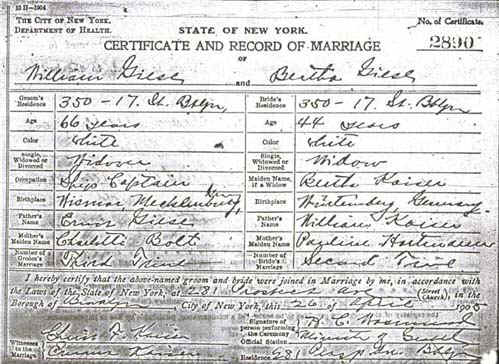
Just 8 months after Pauline's death, he married for a third time in April 1905. Sure
enough, this marriage was in fact to his step-daughter. Looking at the marriage
certificate there were the facts. Her name was Bertha Giese, and her parents were Pauline
Hartmann and William Kaiser, the same names as I had found earlier on the marriage
certificate of Pauline's other daughter. Bertha was, herself, a widow and was 44 years
old, while the great grandfather was 66. While I was a little surprised to see her surname
Giese, this was a fairly common name in the Brooklyn German community. Also her address
was the same as William Sr. so I thought perhaps it might even be a mistake. But where was
the scandal? As far as I could tell, she had never lived in the home with William Sr.
prior to her mother's death and while she was 22 years younger, it was hardly a case of
robbing the cradle.
Bertha was married to William Sr. until his death 5 years later in 1910. Pauline and
William Sr. were buried together in nearby Greenwood Cemetery, even today known as a
somewhat upscale resting place for New York's famous and infamous. When I obtained the
cemetery record I was surprised to find a 3rd person buried in the plot, a John F. Giese
who had been buried October 12, 1897. I wondered if this could be the great grandfather's
half brother, born Johann Friedrich Heinrich Giese in September 1855, in Wismar, to Ernst
Martin Diederich Giese and his third wife, Sophia Wilhelmine Timmermine. I did not suspect
so, given the 18 years difference in age and the distance between Brooklyn and Wismar.
Further, I had found Johann on the 1867 census of Wismar with his mother, sister and his
step-father, a day laborer. His mother had remarried after the death of Ernst Martin, just
a year after Johann's birth.
When I managed to find a copy of John's death certificate, however, it did show him to
be the right age for Wilhelm's half-brother and born in Germany. It also showed he arrived
in Brooklyn about 1881, had died of cerebral apoplexy, his occupation was grocer, he was
married and he had lived at the corner of Jamaica & Railroad Avenues in Brooklyn. It
did not show any next of kin.
Looking in city directories, I found John had his grocery store at 308 18th Street in
Brooklyn, just a block away from the William Sr. home at 350 17th Street. Looking in the
archive of the Brooklyn Eagle newspaper, I found a couple of surprises. Just 2 months
prior to his death he had written to that newspaper with a monetary plan for
"Remedying the Ills Arising From a Double Standard." In the rather lengthy
dissertation, he gave his views on the gold/silver standard of the US, and compared it to
the monetary system of several other countries. At the bottom was his address of Jamaica
& Railroad Avenues. I am still wondering how the knowledge to write such an article
came to him. A second surprise came in finding a death notification indicating his wife's
name was Bertha. A flash came, and I wondered if this could be the same Bertha who married
William Sr.?
Finding the truth turned out to be fairly easy. Looking on the 1900 census taken after
John's death but before Pauline's, I found Bertha, age 40 and a daughter, Anita, age 4
living at the corner of Jamaica & Railroad Avenues. On the 1910 census taken shortly
after William Sr.'s death, there are Bertha, age 49, and Anita, age 14, living at the
great grandfather's home at 350 17th Street. It seems that when Bertha married William
Sr., she was both his sister-in-law and his step-daughter. I now believe Bertha is the one
who buried her husband John, her mother Pauline, and her step-father/brother-inlaw/husband
William, together in one grave. In the process she also managed to make herself the
exclusive beneficiary of the Giese/Geasa estates. I suspect that fact, rather than any
scandal, is the source of discontent passed down by my grandfather William Jr.
Return to Table of Contents
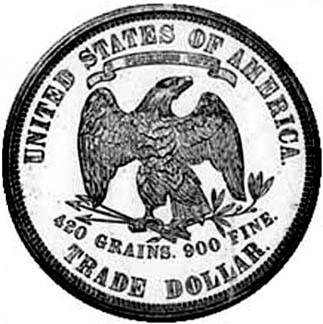 |
Livermore Valley History
Building a Community - It Takes Hard Work
By Gary Drummond |
Building a city government can be a tedious process. An example is the town of
Livermore. The Governor approved the incorporation of our town on April 15, 1876. A month
later, five members of the community were elected to a Board of Trustees.
The new town was without funds, and since no tax levy had been established, the Board
requested the County to turn over the business licenses it had previously issued. Those
provided the first source of revenue. A Town Assessor was appointed, and by August he
presented his first tax roll.
Meantime, the Trustees were busy creating a set of rules (ordinances) by which the town
was to be governed. With the help of the Town Attorney, at each succeeding meeting the
Board considered and passed over 20 new ordinances within two months. As fast as they were
created, several were amended in a short time.
Ordinance #8 required any citizen owning a dog to buy a license for $2.00. Failure to
do so could subject the owner to confiscation of his property and possessions to be sold
at public auction. There appears to be no record of enforcement, but it was repealed and
replaced by Ordinance #55 in August. 1882. This later Ordinance simply taxed dogs at $1
for males and $2 for females, and the Town Marshal provided a dog tag upon payment.
Another was Ordinance #24 that regulated speed of trains through town. Trains were
restricted to 8 miles per hour and they were required to ring the locomotive bell
constantly when within the town limits; they could not block the public streets for more
than 5 minutes. The train engineer could be subject to a fine of $25 to $100. Then,
someone asked if these rules applied to passenger trains: the Trustees quickly exempted
passenger trains from the Ordinance's requirements.
In other news, the Board instructed Fred Anthony, the Town Treasurer, to dispose of all
the "trade dollars" he had accepted for taxes. (Trade dollars had been coined by
the U. S. Government for trade with the Orient and were extensively circulated on the West
Coast. Their value had dropped to actual bullion value, which was 96 cents.) Mr. Anthony
had a problem. To make the books balance, either the Board of Trustees needed somehow to
absorb the 4 cent difference, or it came out of the Treasurer's own pocket. No resolution
appears in the Trustees' Minutes.
From a community of 830 people at incorporation, the early town Boards of Trustees
created a strong government that continues today.
Return to Table of Contents
The Census Taker Rebuffed
|
Census Taker: "Good morning, madam, I'm taking the census."
Old Lady: "The what?"
Census Taker: "The c-e-n-s-u- s!"
Old Lady: "For lans sakes! What with tramps takin' everythin' they kin lay their
han's on, young folks takin' fotygrafs of ye without so much as askin', an' impudent
fellows comin' roun' as wants ter take yer senses, pretty soon there won't be nothin' left
ter take, I'm thinkin'."
1890 Harper's Weekly
Return to Table of Contents
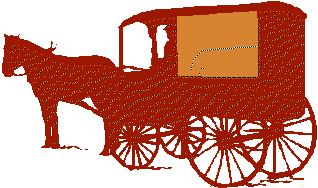 |
The Early Pioneers in Our Valley Were One Big Family
By Isabel Whann Nolte |
About a year and a half ago I had a discussion with Dick Finn about a booklet that I
saw in the reference section of the Livermore Library. The booklet contained the birth and
death dates of some of our old families in Livermore. I noted an error in the Twohey
family and thought it should be corrected. Dick said that it could not be done. He said,
"Why don't you write a book?" I took up the challenge and started on the Fallon
family since my daughter married Frank Fallon.
The first Fallon was William Joseph Fallon, Sr. who came from Galway, Ireland. He and
his wife, Annie (Coppinger), had eleven children. The girls married into the Twohey,
Kelly, Callaghan and Armstrong families. I finally realized that through marriage, the
families became one big family. I know that there were many other families during this
period that were part of the growing of the city of Livermore, but I chose only those that
intermarried.
These are a few of the families that were prominent during the middle 1900s: Armstrong,
Barthe, Callaghan, Devany, Gallagher, Mulqueeney, Murray, Polomono, Coppinger, Croak,
Deck, Donlon, Dolan, Doolan, Fallon, Gleese, Hansen, Kelly, Leaky, Lindner, McGlinchey,
Moy, Mueller, Owens, Murphy, Murray, Nickerson, Owens, Scanlon, Sweeney, Thompson, Twohey
and several more.
Here are some that were prominent citizens:
William Armstrong was Past Grand Chief Ranger and Grand Secretary of
the Foresters of America, Supreme Treasurer of the Foresters of America, Past Grand
President of the Y.M.I., Native Sons of the Golden West, Fraternal Order of Eagles, and
also manager of the Foresters Hall.
John McGlinchey was one of the founders of the Stockmen's Protection
Association.
James E. McGlinchey received the Eagles Outstanding Citizen Award in
1950.
James Moy was one of the founders of the Livermore Rodeo, and also
chairman of the committee that put on the first show in 1918.
Patrick Gallagher and his wife, Elizabeth Leahy Gallagher, had sixteen
children with only fourteen living. Elizabeth was highly respected by many friends for the
work she did for the needy.
John J. Callaghan, Jr. was one of the organizers of the Stockmen's
Protective Association in 1904. He was Past Chief Ranger and one of the oldest members of
Court in Livermore.
James Patrick Gallagher was one of the most prominent sheep growers in
this section of the state for forty years on a ranch south of town.
Many more were prominent in the making of the city of Livermore as it is today. Most of
those who originally settled here were sheep herders, dealt in livestock, and were known
to be lovers of horses.
Being an accountant, I am used to detailed work, but when it comes to assembling,
printing, and editing, I owe a great deal of thanks to Dick Finn who found and corrected
my mistakes. I wish researching my ancestors was as easy as researching the Livermore
settlers. Also, Barbara Bunshah? obituary books were a God send. I hope everyone enjoys my
book because I enjoyed doing it.
The Early Pioneers in The Livermore Valley, California, Were One Big Family.
Isabel W. Nolte. 2007, 192 pages, soft cover, spiral binding, indexed, includes
photographs. The author traces many of the pioneer Livermore Valley families related to
her daughter's late husband, Frank Fallon. These families include Armstrong, Callaghan,
Collier, Croak, Dolan, Doolan, Fallon, Gallagher, Kelly, Moy, Murray, Nickerson, Twohey,
and several more. Printed with permission of the author by the Livermore-Amador
Genealogical Society. Members: $17.00, non-members $25.00, shipping $3.50.
Return to Table of Contents
These are copies of actual correspondence received by the Family History Department
in Salt Lake City.
“Our 2nd great-grandfather was found dead crossing the plains in the library.”
“My Grandfather died at the age of 3.”
Previously published in RootsWeb Review: 07 Feb 2007, Vol. 10, No. 6.
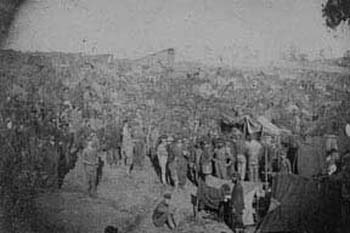
|
Andersonville -
"...somebody's darling boy, dead, yet breathing."
By Debbie Pizzato |
| A.J. Riddle took this photograph on August 16, 1864,
the day Royal died of starvation. |
|
My great-great grandmother, Sarah Jane Haning, named all her children after famous or
well-known people, and after lesser-known but not forgotten relatives, like her cousin,
Royal Hoyt.
Royal Hoyt's life began in Meigs County, Ohio and ended in the squalor of Andersonville
Prison in Georgia. In 1862, during the Civil War, Royal, a young farmer, enlisted for 3
years as a wagoner in Company B, 116th Infantry Regiment Ohio.
The 116th was organized at Marietta and Gallipolis, Ohio in August of 1862 under
Colonel James Washburn and served in West Virginia. The Regiment joined Meade's army on
its return from Gettysburg, and by April 1864, marched with Siegel down the Shenandoah
Valley where it met with a great loss of 176 men. In June it moved to Lynchburg, Virginia
where on June 18, 1864, Royal, age 24, was taken captive by the Confederate Army.
Most likely upon his arrival at the Andersonville train depot, Royal, was lined up,
along with many other prisoners, and ordered to walk the 800 paces to the north gate of
the South's most notorious prison. These prisoners, some already starving and in very poor
condition, were to undergo a conflict worse than any battle they had ever fought. They
were about to begin a fight for life.
G.E. Reynolds, Co. F, 86th Ohio Infantry, recalled his arrival at Andersonville by
writing, "As the heavy wooden door closed behind us my heart sank within me, and hope
which till that time had buoyed me up, fled. And such a sense of utter and hopeless
desolation crept over me as I hope never to feel again."
While the month of June found the prison authorities pleading for supplies and doctors,
Private Aslaksan, 9th Minnesota Cavalry wrote, "The sight of all this misery, the
starved, dying and half-naked humans all around, those with scurvy, misshaped limbs,
swollen limbs, swollen joints, and festering sores infected with gangrene, all contributed
to make the newcomer so unnerved that he would soon get into a mental condition of despair
out of which the ghost beacon of death seemed welcome."
Andersonville, or Camp Sumter as it was officially known, was a large military prison
established during the Civil War. It was built in 1864, with the first prisoners arriving
in February. Approximately 400 more arrived each day during the next few months and by the
end of July, 31,678 men were confined in a prison originally built for 10,000. During the
14 months of its existence, more than 45,000 Union soldiers were confined there. Of these,
12,912 died from disease, malnutrition, overcrowding or exposure.
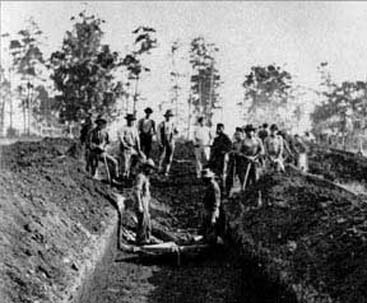 |
The bodies were laid to rest side-by-side in six-foot
wide by three-foot deep trenches.
A.J. Riddle took this photo at the cemetery in the summer of 1864. |
In August 1864, there were almost 33,000 prisoners confined within Andersonville's 26
acres. Royal Hoyt was among the 2,933 prisoners that died during this month. As Private
Northrup, 7th Connecticut Infantry, wrote, "One poor boy near cried all night and
wished to die and suffer no longer; he is an awful object; his clothing is gone but a rag
of a shirt; his body is a mere frame; his hair has fallen out from his head; his scurvy
ankles and feet are as large as his waist. I never saw a sight more appalling. Than the
awful thought that he is a man, somebody's darling boy, dead, and yet breathing." And
so it went.
On July 25, 1865 Clara Barton arrived in Andersonville with an expedition of 37 men.
With the help of Dorence Atwater's death list, she used painted boards to mark the graves
of the prisoners who had died. A year after Royal's death, Clara helped to dedicate the
cemetery on August 17, 1865.
What became of the prisoners who left Andersonville? Many died on their way home when
the steamboat Sultana exploded and sank. Others died in Northern hospitals, or in their
hometown, of the diseases incurred at Andersonville. Some survived and many used the
written word to tell a tragic story. And some family members named their children after
those who rendered service to our country.
Two good sources I use for Andersonville are: http://www.sinclair.edu/sec/his102/mcknight/bm06.htm
National Park Civil War Series, The Prison
Camp at Andersonville.
Return to Table of Contents

|
New at The Pleasanton Genealogy Library
Courtesy of Carl Cousineau
Library Services Manager |
- Mapping Human History: Discovering the Past Through Our Genes
- Olson, Steve, 1956-
599.9 OLSON
-
- Saxons, Vikings and Celts: The Genetic Roots of Britain and Ireland
- Sykes, Bryan.
599.935 SYKES
-
- Dating Old Photographs: 1840-1929
- 929.1072 DATING
-
- Unlocking the Secrets in Old Photographs
- Frisch-Ripley, Karen, 1955-
929.1072 FRISCH-RIPLEY
-
- More Dating Old Photographs: 1840-1929
- 929.1072 MORE
-
- Finding Your Mexican Ancestors: A Beginner's Guide
- Ryskamp, George R.
929.107208968 RYSKAMP
-
- Raking the Ashes: Genealogical Strategies for Pre-1906 San Francisco Research
- Peterson, Nancy Simons
929.37946 PETERSON
-
- Centerville Pioneer Cemetery: Fremont, Alameda County, California
- Veronda, Romaine Throckmorton
929.50974 VERONDA
-
- Family Tree Maker Social Security Death Index, 1937-1999 [Computer File]
- CD-ROM 929.373 FAMILY
Return to Table of Contents
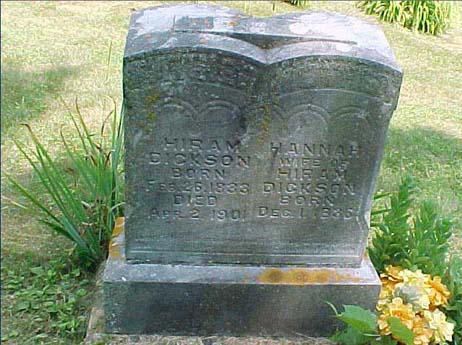
|
I Recommend -
Free Treasures on USGenWeb
By Lois Barber |
Tombstone of my relatives from Vernon County,
Wisconsin. |
|
During a recent stint at the Pleasanton Library as the Genealogy Docent, I had time to
do some personal research. This is a perk you might consider when you volunteer as a
Docent. I browsed through Ancestry, RootsWeb and USGenWeb looking for new things that had
been added since I last had time to visit.
I was born and raised in Richland County, Wisconsin, so of course that was the state
that I clicked on at the USGenWeb site. If you want to follow my trail I next clicked on
Wisconsin Resources, Tombstone Photograph Pages, Vernon County, and Union West Lima
Cemetery. Scrolling down, there were my Dickson relatives! Little Anna J., Great-
Grandparents Hiram and Hannah Dickson, and James. Although I have visited this cemetery
and taken pictures of these stones, it was a heart-warming feeling to see that someone
cared enough to do this work.
What is available state-by-state is a real eyeopener. Some have volunteers that must be
really dedicated and others are severely lacking. I recommend a surfing visit to each of
the counties on GenWeb that is involved in your family history.
http://www.usgenweb.org/
The total amount of information posted there by kind volunteers is amazing. And it is
free of all costs to you.
Return to Table of Contents
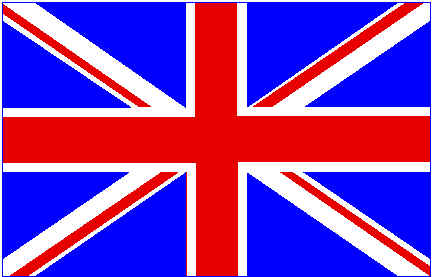
|
You'll Still Wait 100 Years to See UK Census Returns
By Linda Garrett |
I came across a petition that went to the Prime Minister of England in March of
this year requesting lowering of the opening of census records from 100 years to 70 years,
as is the case in the U.S. This was the response from the office of the Prime Minister of
England:
Thank you for signing the e-petition calling for the closure period on census data to
be reduced from its present 100 years to 70 years for the 1911, 1921 and 1931 censuses.
The Government understands the frustrations this delay can cause, particularly to
people who are researching their family history. But these frustrations have to be
balanced against the assurances given to people at the time about confidentiality. This
also has implications today, for public confidence in the privacy of information which
people provide in future censuses.
Clearly, the importance of the personal information provided in the census is that it
enables a detailed and accurate picture to be built up of our society. This is of great
assistance to Government and to the community as a whole in helping shape policies and set
priorities for the future. But unless people believe that the personal data they provide -
which includes details of their occupation and who is living with them - will remain
confidential and secure as they have been promised, the danger is that they might feel
reluctant to give sensitive information.
It is for this reason that there is a policy of a 100-year delay before releasing the
personal data in the census. The purpose is to minimize the risk of embarrassment both to
those living and to their immediate descendants. The Government does not believe this
policy should be altered or the explicit assurances given to people at the time broken.
On a sadder note, the 1931 census records were destroyed by fire during the Second
World War.
We know this reply will disappoint many people, but hope you will understand that in
the long-term, the reasons given are in the best interests of preserving the census for
future generations.
Return to Table of Contents
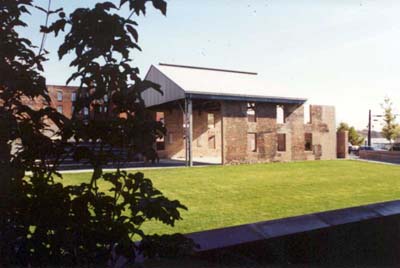
|
Women's Rights National Park
By Jane Southwick |
Wesleyan Chapel
The site of the First Women's Rights Convention held July 19 and 20, 1848 in Seneca Falls,
New York. |
|
There are many resources available to locate missing ancestors, but sometimes an
off-beat source can prove valuable. Have you ever wondered if any of your ancestors were
involved in the Women's Suffrage movement of 1848?
Patrick Lofft and his wife, Charlotte, visited the Women's Rights National Park in
Seneca Falls, New York, in June of 2007. They e-mailed the web address - http://www.nps.gov/wori/historyculture/declaration-of-sentiments.htm
- to some of the members of L-AGS.
In addition to the Declaration of Sentiments, the web site gives information about the
park. It describes with pictures and text some of the historic properties which include: a
state-of-the-art visitor center; the Wesleyan Chapel where the first Women's Rights
Convention was held; and the home of Elizabeth Cady Stanton, who was the driving force
behind the 1848 convention.
It was interesting to read the 100 names of the signers of the Declaration of
Sentiments, which asked for equality for women. Some of these men and women were related,
and because a biography is given for many of them, you may be able to find a relative who
was involved in an historic time in our country.
Return to Table of Contents




